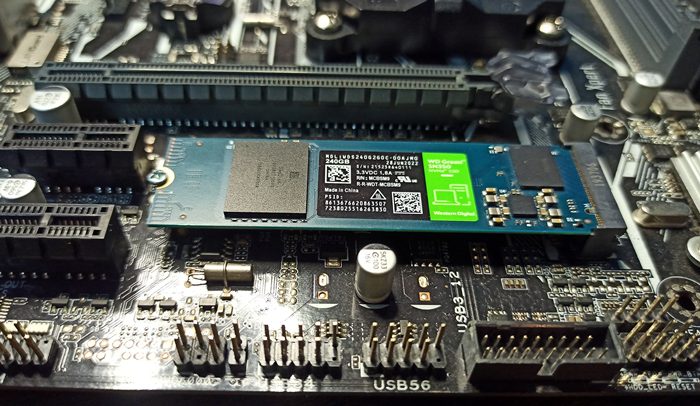Affiliate Disclosure: This post may include affiliate links. If you click and make a purchase, I may earn a small commission at no extra cost to you.
There are many competitors to the Samsung 990 Pro, and we have compared most of them before. But, there is a relatively new competitor in the market, i.e., WD Black SN7100. Both of these are Gen 4.0 SSDs with TLC NAND flash. The theoretical read/write speed numbers are almost equal. Both have the same TBW, warranty period, and other key features.
However, the biggest difference, and perhaps the deciding factor for most, is the DRAM. SN7100 is a DRAM-less SSD, while the Samsung 990 Pro has its own DRAM.
But the SN7100 is way cheaper than the 990 Pro, and this is where your decision may change. Obviously, you would want to compare the performance, which we will do later in the article, but the amount of money you save can have a serious impact on your purchase decision.
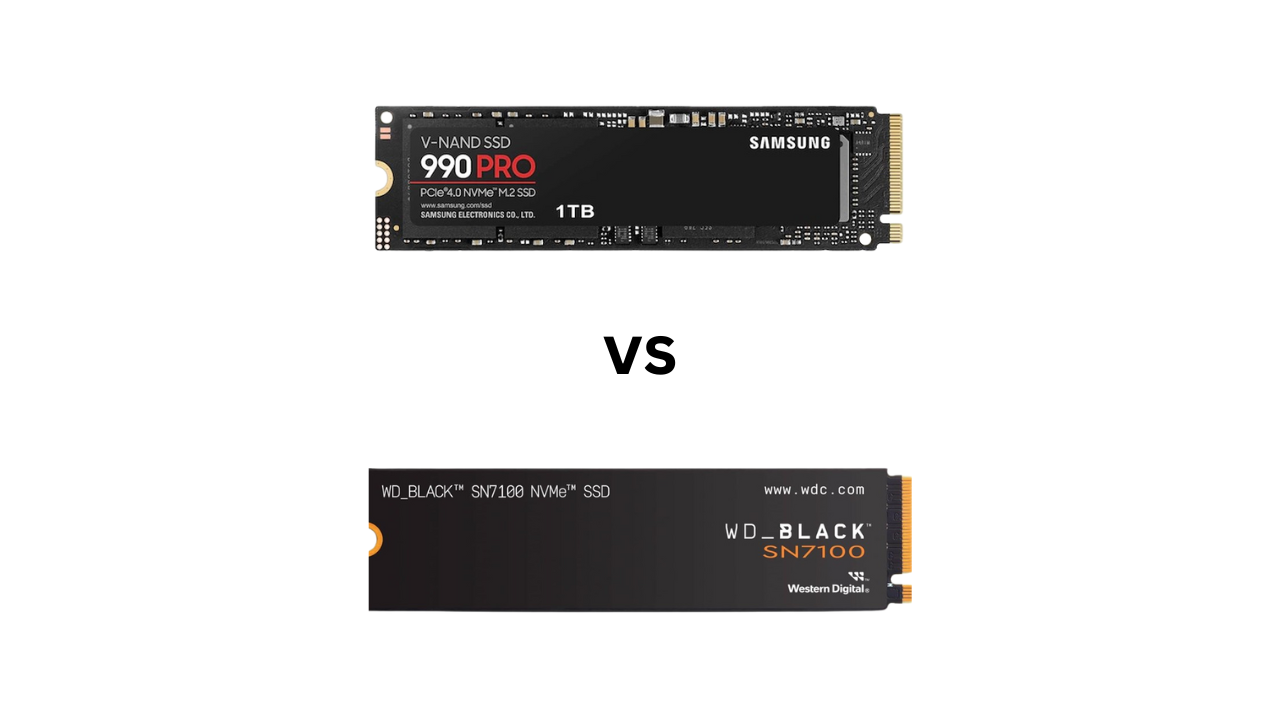
Specifications Comparison
| Specification | Samsung 990 Pro | WD Black SN7100 |
|---|---|---|
| PCIe Generation/NVMe Version | PCIe Gen 4.0 x4 / NVMe 2.0 | PCIe Gen 4.0 x4 / NVMe 2.0 |
| Release Date | Aug 24th, 2022 | Nov 21st, 2024 |
| Capacities | 1TB, 2TB, 4TB | 500GB, 1TB, 2TB, 4TB |
| NAND Flash | Samsung V-NAND TLC (176-Layers) | Kioxia’s BiCS8 TLC rebranded as SanDisk 022644 2T00 4422D1JX403Q (218-Layer) |
| Sequential Read Speed | Up to 7,450 MB/s | Up to 7,250 MB/s |
| Sequential Write Speed | Up to 6,900 MB/s | Up to 6,900 MB/s |
| Random Read Speed | 1TB: 1,200K IOPS 2TB: 1,400K IOPS 4TB: 1,600K IOPS | 500GB: 760K IOPS 1TB: 1,000K IOPS 2TB: 1,000K IOPS 4TB: 900K IOPS |
| Random Write Speed | Up to 1,550,000 IOPS | 500GB: 1,200K IOPS 1TB: 1,400K IOPS 2TB: 1,400K IOPS 4TB: 1,350K IOPS |
| DRAM | DRAM (~1GB per 1TB) | None (HMB) |
| Heatsink Option | Yes | No |
| Datasheet | Samsung | SanDisk |
The sequential read/write performance numbers are almost the same in both. But, in the theoretical random read/write IOPS, the Samsung 990 Pro has much better performance to offer. Again, the absence of DRAM in the SN7100 can sometimes hamper performance. However, the modern HMB algorithms are pretty effective in replacing the DRAM.
Benchmark Scores Comparison
All the comparisons are for the 2TB variants of both drives.
PCMark 10 Benchmark Scores

The Samsung 990 Pro edges out the WD Black SN7100 in all PCMark 10 benchmarks, though the differences are slight. In the overall PCMark 10 score, the 990 Pro reaches 4617, beating the SN7100’s 4561 with a 56-point lead, and by a small percentage of ~1.2%. Bandwidth shows a similar gap, with 743 MB/s vs. 734 MB/s, translating to a 9 MB/s advantage (~1.2%) for Samsung. Latency favors the 990 Pro as well, at 36.0 ms vs. 37.0 ms, meaning a 1 ms improvement. In real-world use, these margins are so narrow that most users will experience nearly identical performance in gaming, productivity, or general workloads, with the Samsung only slightly better suited for latency-sensitive tasks.
3DMark Storage Test for Gamers
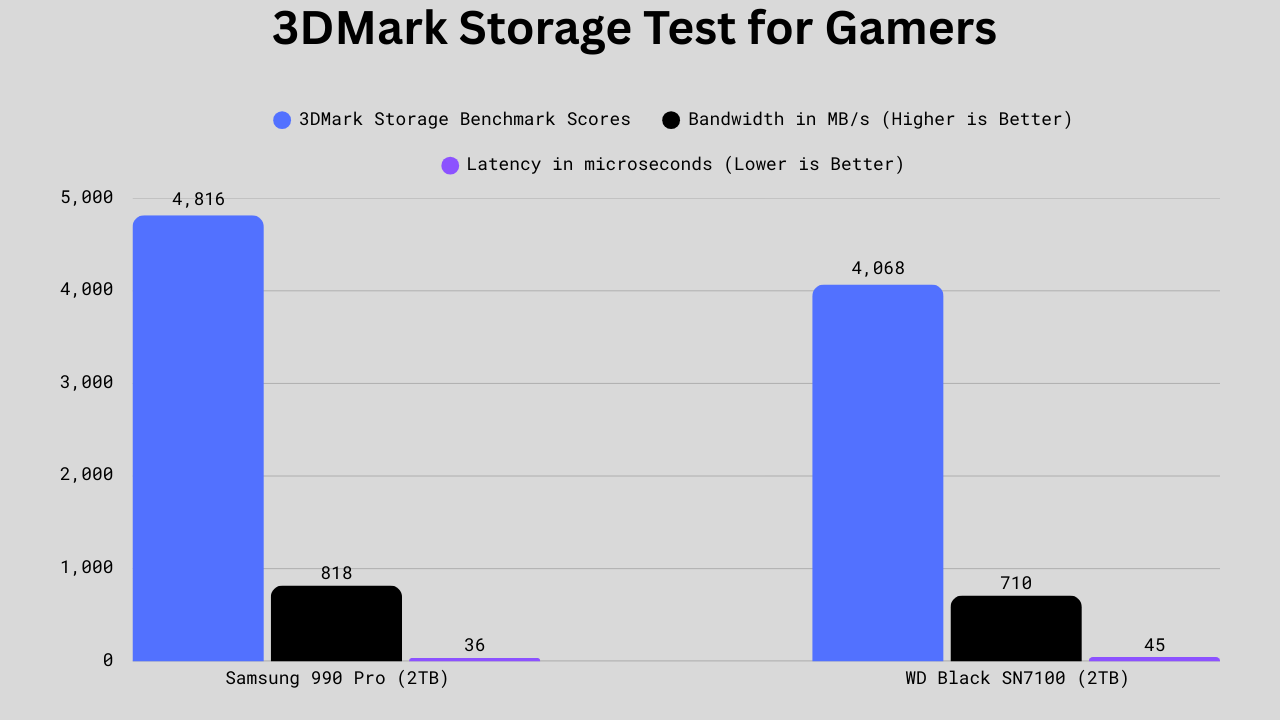
In the 3DMark Storage Benchmark, the Samsung 990 Pro clearly outperforms the WD Black SN7100 across the board. The 990 Pro scores 4,816 vs. 4,068, a 748-point lead (~18.4%). Bandwidth is also higher at 818 MB/s vs. 710 MB/s, giving Samsung a 108 MB/s advantage (~15.2%). Latency favors the 990 Pro with 36 µs compared to 45 µs, an improvement of 9 µs (~20%). In real-world terms, this translates into faster game load times, smoother handling of large files, and noticeably better responsiveness in demanding tasks such as gaming or 4K video editing, making the Samsung drive the stronger choice for performance-focused users.
CDM Sequential Read/Write Performance

Looking at sequential performance, the WD Black SN7100 slightly outpaces the Samsung 990 Pro in most areas. For peak sequential QD1 read, the WD hits 5,012 MB/s vs. 4,637 MB/s, a 375 MB/s lead (~8.1%). In QD1 write, it’s again ahead at 6,040 MB/s vs. 5,898 MB/s, or a 142 MB/s margin (~2.4%). At higher queue depths (QD8), reads are essentially tied with 7,137 MB/s vs. 7,153 MB/s, a negligible 16 MB/s difference (<0.3%), while writes give the WD 6,860 MB/s vs. 6,820 MB/s, a 40 MB/s lead (~0.6%). In real-world terms, these differences are minimal; the WD may open large files a fraction faster, but both drives deliver near-identical responsiveness in everyday workloads.
CDM Random Read/Write Performance
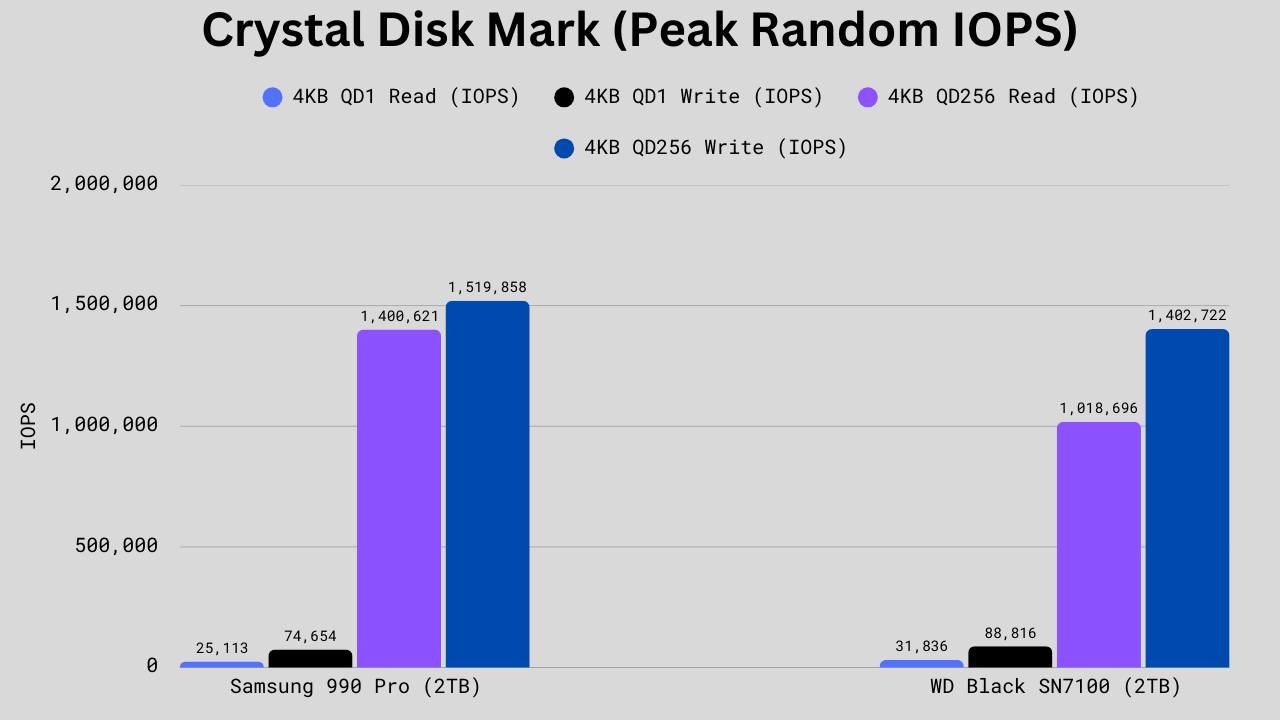
In random 4K performance, the Samsung 990 Pro and WD Black SN7100 trade blows depending on workload. At low queue depth, the WD leads with 31,836 IOPS vs. 25,113 IOPS in 4K QD1 read, a 6,723 IOPS advantage (~26.8%), and 88,816 IOPS vs. 74,654 IOPS in 4K QD1 write, giving it a 14,162 IOPS lead (~19%). However, at high queue depth (QD256), the Samsung pulls far ahead in reads with 1,400,621 IOPS vs. 1,018,696 IOPS, a massive 381,925 IOPS lead (~37.5%), and it also leads in writes with 1,519,858 IOPS vs. 1,402,722 IOPS, a 117,136 IOPS edge (~8.4%). In real-world usage, the WD may feel snappier for light desktop tasks like launching apps, but the Samsung shows its strength in heavy multitasking, large data transfers, and workstation-class workloads.
Transfer Rate
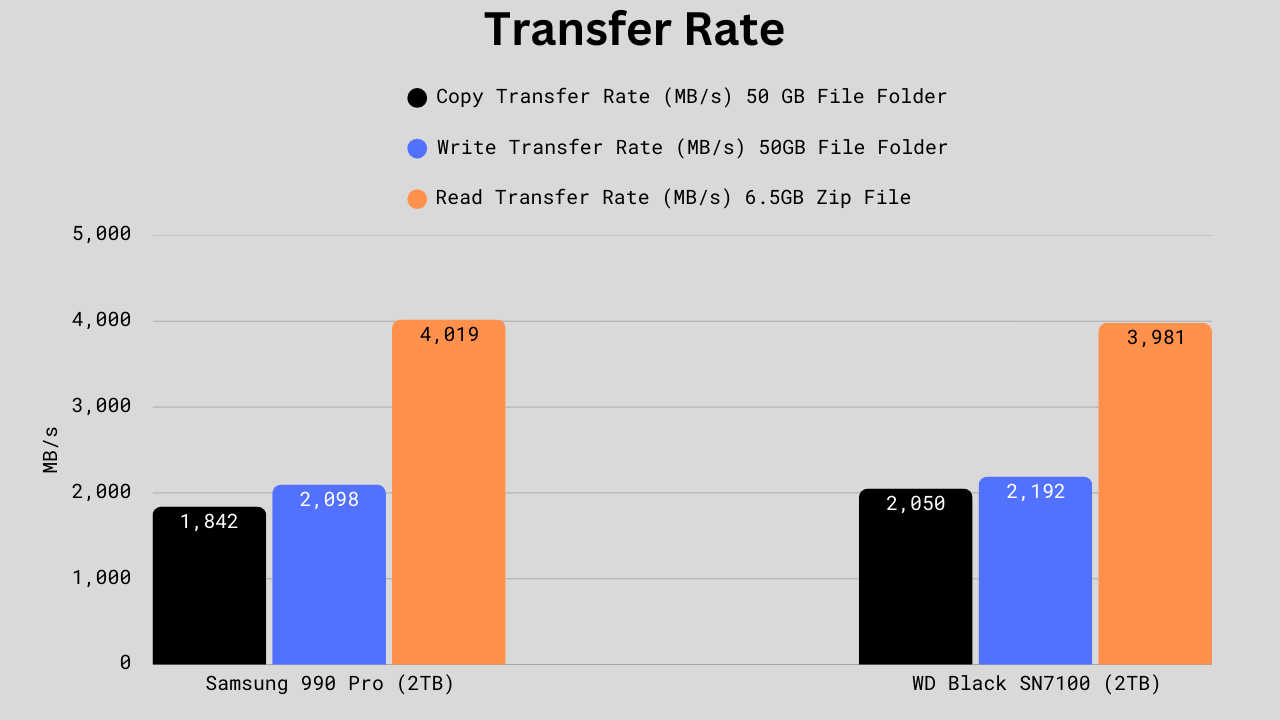
In real-world transfer scenarios, the WD Black SN7100 edges out the Samsung 990 Pro in two of the three tests. For a 50GB file folder copy, the WD hits 2,050 MB/s vs. 1,842 MB/s, a 208 MB/s lead (~11.3%). In 50GB write transfers, it maintains the advantage with 2,192 MB/s vs. 2,098 MB/s, a 94 MB/s gain (~4.5%). However, in the 6.5GB zip read test, the Samsung pulls slightly ahead with 4,019 MB/s vs. 3,981 MB/s, a modest 38 MB/s margin (~1%). In practice, this means the WD will generally finish large copy and write operations a bit faster. At the same time, Samsung keeps a slight edge in compressed file reads—though for most users, the differences will be barely noticeable.
Power Consumption and Efficiency

In terms of power efficiency, the WD Black SN7100 (2TB) shows a clear advantage over the Samsung 990 Pro (2TB). For 50GB file copies, it delivers 729 MB/s per watt vs. 457 MB/s per watt, a 59.5% efficiency gain, while also drawing less power on average (3W vs. 4W, a 25% reduction). Idle consumption is lower too at 969 mW vs. 1,252 mW, a 22.6% savings, and maximum draw favors the WD at 4.10W vs. 5.88W, a 30.3% lower peak. This is primarily because of the absence of DRAM in SN7100. In real-world use, this means the WD runs cooler and more efficiently, making it a better fit for laptops and energy-conscious setups, while still offering top-tier performance.
TBW, DWPD, MTBF, and Warranty Period
| Specification | Samsung 990 Pro | WD Black SN7100 |
|---|---|---|
| Endurance (TBW) | 1TB: 600 TBW 2TB: 1,200 TBW 4TB: 2,400 TBW | 500GB: 300 TBW 1TB: 600 TBW 2TB: 1,200 TBW 4TB: 2,400 TBW |
| Warranty | 5 Years | 5 Years |
| DWPD | 0.3 | 0.3 |
| MTBF | 1.5 Million Hours | Unknown |
All the endurance and reliability specifications, such as TBW, DWPD, and warranty period, are the same.
Technical Specifications
| Specification | Samsung 990 Pro | WD Black SN7100 |
|---|---|---|
| Controller | Samsung Pascal (S4LV008) | WD Polaris 3 A101-000172-A1 |
| Controller Architecture | ARM 32-bit Cortex-R8 | ARM Cortex-R |
| Process | 8 nm | 16 nm |
| DRAM Specifications | LPDDR4-4266 DRAM | DRAM-Less (Host-Memory Buffer Enabled) |
| SLC Write Cache | 1TB: approx. 114 GB (108 GB Dynamic + 6 GB Static) 2TB: approx. 226 GB (216 GB Dynamic + 10 GB Static) 4TB: approx. 442 GB (432 GB Dynamic + 10 GB Static) | 500 GB: – Data not available 1TB: – Data not available 2TB: approx. 650 GB (dynamic only) 4TB: |
| NAND Flash | Samsung’s V-NAND V8 TLC | Kioxia’s 218-Layer TLC (BiCS8) |
| NAND speed | 2400 MT/s | 3,600 MT/s |
| Encryption | AES-256, TCG Opal | No |
| Power Loss Protection | No | No |
| SMART/TRIM/PS5 Support | Yes/Yes/Yes | Yes/Yes/Yes |
Samsung’s controller is much more refined and based on a smaller process than the SN7100. Again, there is the DRAM-Less in the 990 Pro. But, the SN7100 2TB has employed a bigger SLC Write cache of 650 GB as compared to 990 Pro’s 226GB, from which the 216 is dynamic. The raw NAND speed is higher in the Kioxia’s BiCS8 NAND flash utilized in the SN7100. Overall, the tech specs have no huge differences except the DRAM-Less design.
Price


Final Verdict
Lack of DRAM in an SSD can result in increased latency, slower random performance, performance drops under load, and reduced endurance. So, if you are fine with all these drawbacks, you can surely go for the SN7100 and save money. It will run cooler and also consume less power. You can go for the higher capacity with a better price-per-GB.
However, if you are looking for the best performance, responsiveness, and brand value, but are ready to pay a little more, you should go for the Samsung 990 Pro. In fact, it is one of the leading SSDs in the Gen 4.0 high-end NVMe category. As a primary OS drive, it could be the best investment you can make.
I hope this helps.



